Pesto alla Trapanese is a Sicilian pesto typical to the province of Trapani. It's made with tomatoes, almonds, basil, garlic and extra virgin olive oil.
It's texture is creamy and a little chunky at the same time. You can feel delicious sweetness of the tomatoes, paired with pleasant unique spiciness of garlic, basil and olive oil.

Just like basil Pesto Genovese, it's traditionally made with mortar and pestle which gives it its creamy consistency and unforgettable flavor. In this recipe I'll show you a little trick on how to preserve all the qualities of authentic Pesto alla Trapanese while making it in a food processor.
Table Of Contents
Curiosity
As its name implies it’s a typical pesto from province of Trapani.
In ancient times, ships coming from Genoa to the port of Trapani brought their traditional raw sauce made with garlic and nuts, called “l'agliata ligure”
As time went by, local sailors added their typical foods like almonds and fresh tomatoes. And this is how we know Pesto Alla Trapanese today.
Its lightly crumbly texture (just enough to feel the crunch of almonds) and delicate taste makes it a perfect pair to any kind of pasta: served warm or cold!
Ingredients & Substitutes
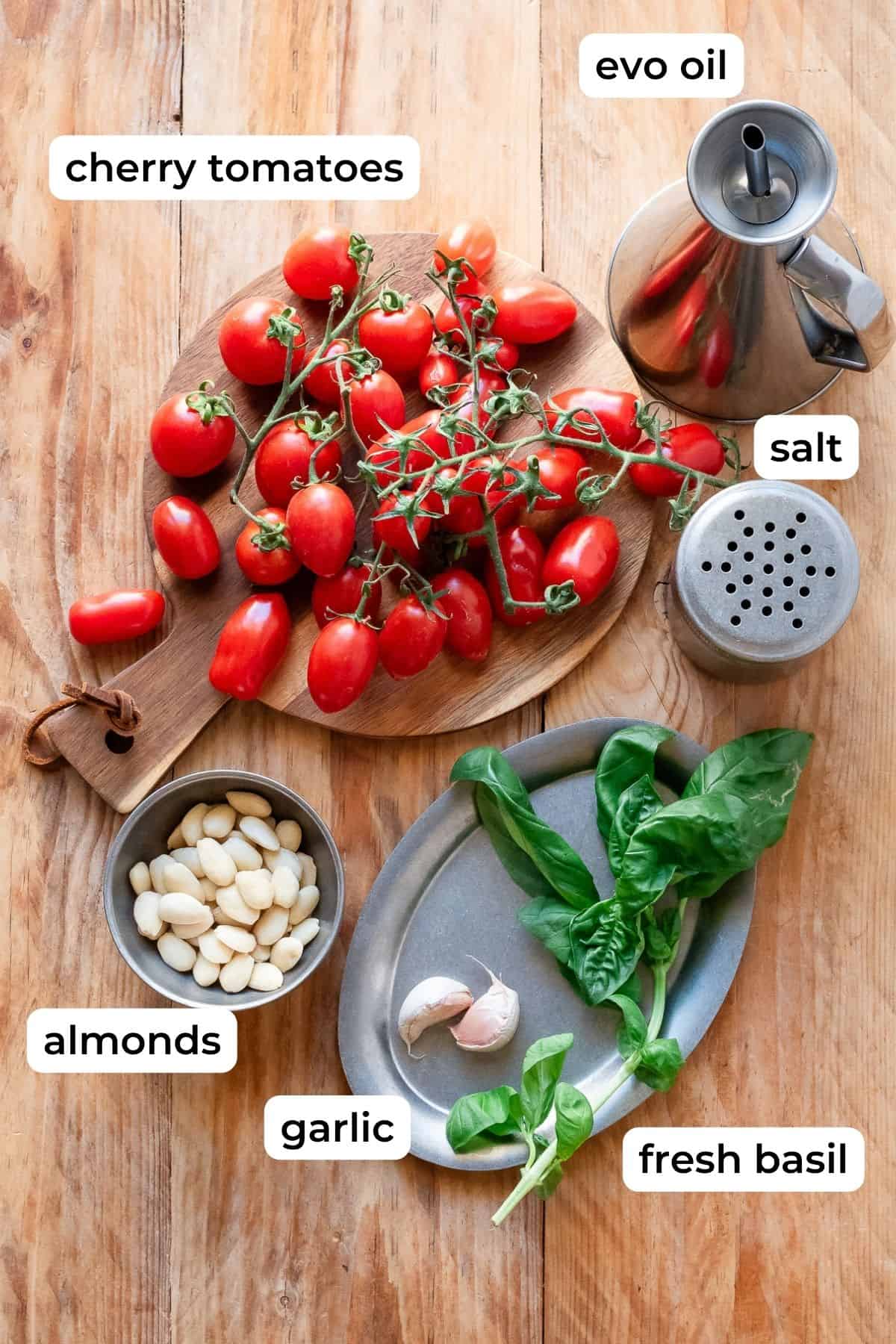
- Cherry or Grape Tomatoes - preferably locally harvested at the peek of the season. They have thin skin and very sweet. Ripe heirloom tomatoes is a good substitute. Seasonal plum tomatoes or San Marzano tomato can also be used but you'll need to blanche them in hot water for 30 seconds, then dip in ice water, peel the skin and remove any water and seeds.
- Almonds - a signature ingredients that give flavor and texture to Pesto Alla Trapanese. You'll need skinless (blanched) almonds that you can get at the store or blanche them yourself.
- Fresh basil - a 6-inch sprig of fresh basil is all you need.
- Garlic - start with the amount indicated in the recipe and they adjust it to your liking. Authentic recipe requires a LOT of garlic, but excess of it is way overpowering. For someone who doesn't like/ want garlic at all, do NOT omit it completely. Simply use half or a quarter of a clove. I find this quantity very appropriate when serving it for big crowds.
Variations
- Pecorino cheese - some Sicilians like to add a few tablespoons of freshly grated Pecorino cheese. You can give it a try by adding the grated cheese after pesto is ready.
- Peperoncino - or hot pepper (chili) flakes. Gives an extra punch of flavor. You can add just a small pinch for very subtle spiciness or more to you liking. Add before blending almonds and garlic.
How To Make - Step By Step Pictures
See the recipe card for full information on ingredients and quantities.
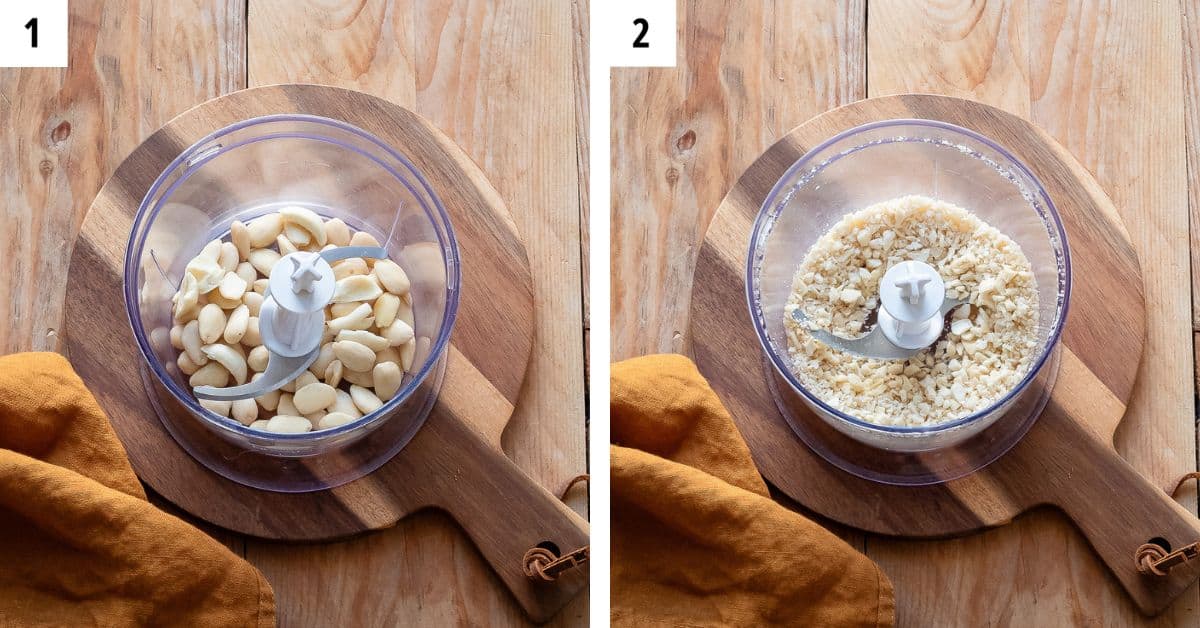
- Place blanched almonds and peeled garlic in a food processor. Pulse until you get crumbly consistency (photos 1, 2).
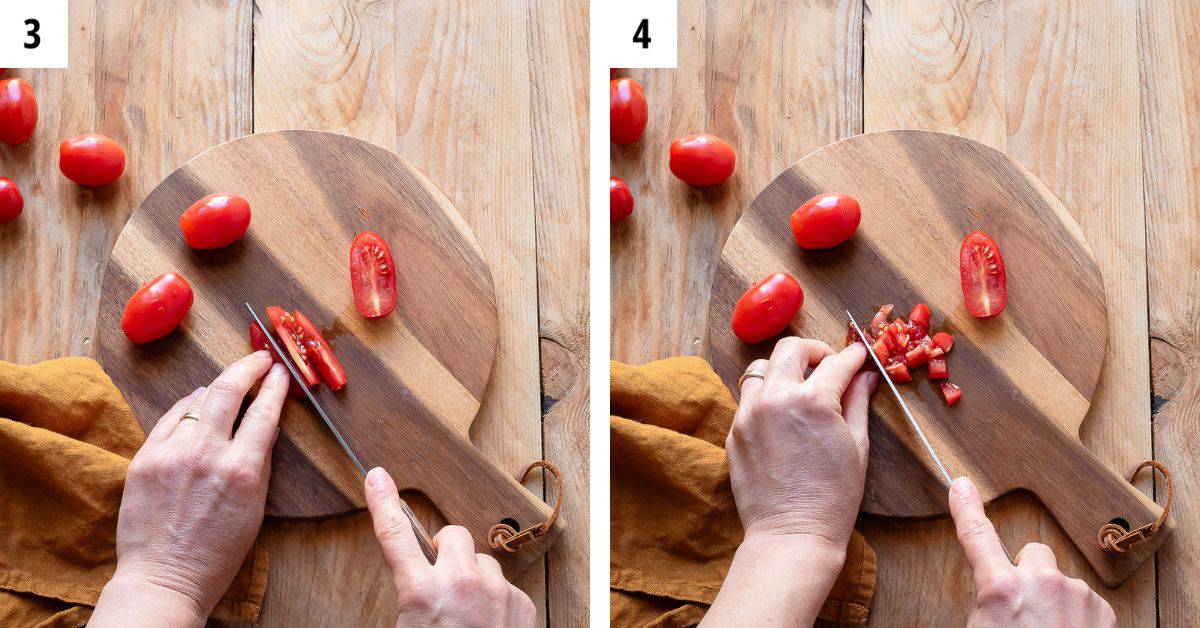
- Cut cherry tomatoes into small cubes. This will help eliminate excess water and blend in as few pulses as possible (photos 3, 4).
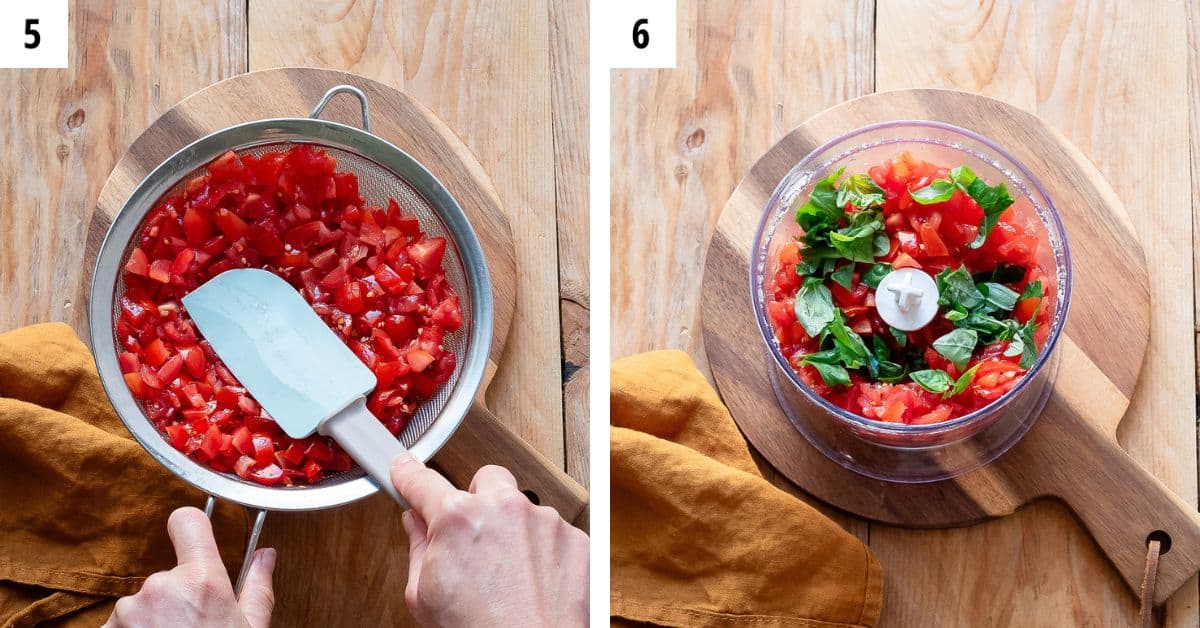
- Add a pinch of salt, mix, and place in a strainer to eliminate excess liquid. Let sit for 5 minutes then press with a spatula (photo 5).
- Add strained tomatoes and hand torn basil leaves to the almond crumble (photo 6. Pulse a few times making frequent stops until creamy but still rustic consistency.
How To Serve
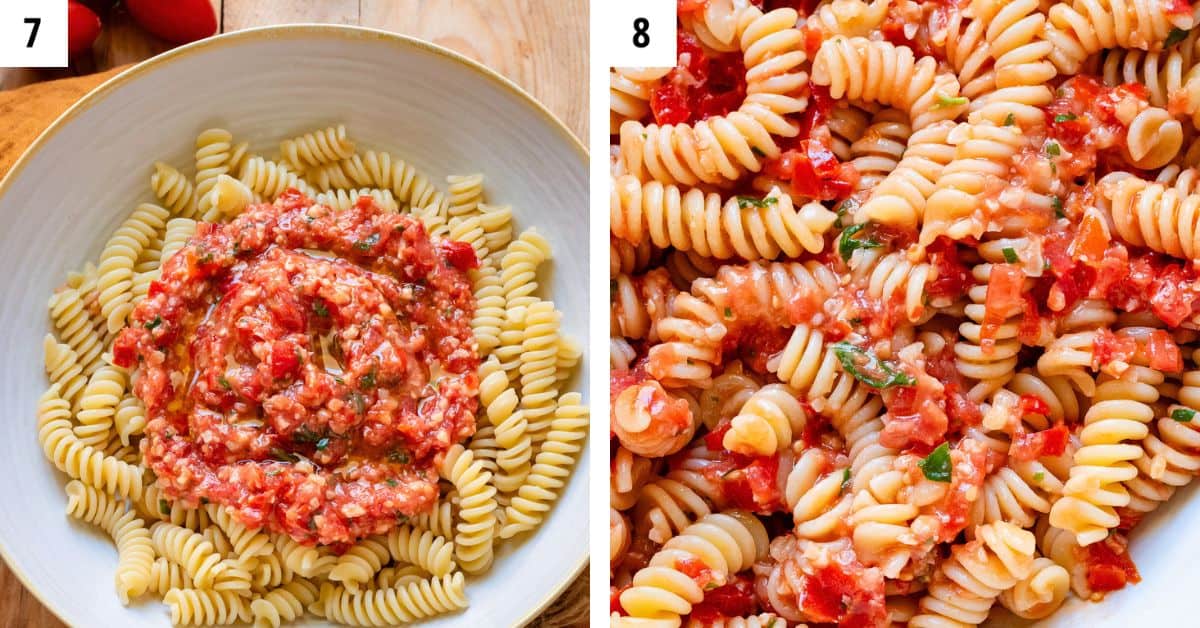
- Boil pasta in well salted water until 'al dente'. Drain and transfer in a bowl. Top with Pesto Trapanese (photo 7) mix adding a little more extra virgin olive oil if needed (photo 8).
- It's delicious served warm or cold.
Good To Know
The most typical and traditional way to serve Pesto Trapanese is with busiate pasta - type of long, thin hollow tube pasta twisted in the way that it resembles a telephone cord. But it pairs wonderfully with durun wheat fusilli (in the photo) that resemble busiate pasta and welcome pesto in its cavities.
Pesto Alla Trapanese, aside of being used as a pasta condiment is also used in another typical Sicilian dish -babbaluci cu l'agghia - snails cooked and seasoned with Pesto Trapanese.
Top Tips
- Choose the right tomato variety. Since all ingredients in Pesto Trapanese are raw, you'll literally get what you put in it. Bland testing tomatoes will result in a bland-tasting pesto. I highly recommend cherry or grape tomatoes for their sweetness and thin skin. See the ingredients and substitutes section for more details.
- Cut tomatoes in small cubes. This is a crucial step that does two things:
- helps eliminate excess water from the tomatoes
- helps get the perfectly consistency in a blender with a just a few pulses.
- Strain excess water from the tomatoes. You don't want your pesto to be watery!
- Don't over-pulse. Overpulsing this Sicilian pesto will result in a mush lacking flavor and texture. For this reason we pulsed almonds and garlic first (since they require more time to be ground) and then added tomatoes cut in small cubes so that tomatoes would be blended in as MINIMUM pulses as possible.
- Don't cook it in the pan. Season pasta in a large bowl away from the heat. This is the beauty of this pesto that it's best flavors come out raw.
FAQs
If you're using cherry tomatoes and small grape tomatoes there's no need to blanche them since their skin is very thin. If you're using classic tomatoes like plum, Roma or San Marzano it's best to blanche them to remove the skin.
Put a small pot of water to boil. Cut an X into the top of each tomato. Once water is boiling immerse tomatoes for 60 seconds. Transfer tomatoes into a bowl with cold water. Peel off tomato skin. Remove extra water and seeds.
If you don't have blanched (skinless) almonds here's how you can easily remove the skin (blanch) them yourself.
Put a small pot of water to boil. Once water is boiling drop 5-10 almonds at a time, boil for 60 seconds then transfer in a bowl with cold water. Take each almond and peel the skin which will easily come off. Repeat the process with the remaining almonds.
More Italian Recipes Using Tomatoes
If you love this Sicilian Pesto that burst with sweet tomato flavor, try also:

Love Italian Food?
Sign up for our weekly newsletter to receive tips, tricks and new recipes delivered straight to your inbox!
Full Recipe

Pesto Alla Trapanese (Sicilian Pesto)
Ingredients
- 14 oz cherry tomatoes (400 grams or 30 cherry tomatoes)
- 1 sprig fresh basil (10 grams) - 6-inch sprig
- 4 tablespoon blanched almonds (50 grams)
- 4 tablespoon Extra virgin olive oil or a little more if needed
- 2 garlic clove , more or less to taste
- pinch Salt
Instructions
Make Pesto Alla Trapanese
- Place blanched almonds and peeled garlic in a food processor. Pulse until you get crumbly consistency.
- Cut cherry tomatoes into small cubes. Add a pinch of salt, mix, and place in a strainer to eliminate excess liquid. Let sit for 5 minutes then press with a spatula.
- Add strained tomatoes and hand torn basil leaves to the almond crumble. Pulse a few times making frequent stops until creamy but still rustic consistency.
Season Pasta
- Boil pasta in well salted water until 'al dente'. Drain and add to a bowl. Top with Pesto Trapanese, mix adding a little more extra virgin olive oil if needed.
- It's delicious served warm or cold.
Notes
- Cut tomatoes in small cubes. This is a crucial step that does two things:
- helps eliminate excess water from the tomatoes
- helps get the perfectly consistency in a blender with a just a few pulses.
- Strain excess water from the tomatoes. You don't want your pesto to be watery!
- Don't over-pulse. Over-pulsing this Sicilian pesto will result in a mush lacking flavor and texture. For this reason we pulsed almonds and garlic first (since the require more time to be ground) and then added tomatoes cut in small cubes so that tomatoes would be blended in as MINIMUM pulses as possible.
- Don't cook it in the pan. Season pasta in a large bowl away from the heat. This is the beauty of this pesto that it's best flavors come out raw.
- Choose the right tomato variety. Since all ingredients in Pesto Trapanese are raw, you' literally get what you put in it. Bland testing tomatoes will result in a bland tasting pesto. I highly recommend cherry or grape tomatoes for their sweetness and thin skin. See ingredients and substitutes section for more details.
Nutrition
Nutrition information is automatically calculated, so should only be used as an approximation.



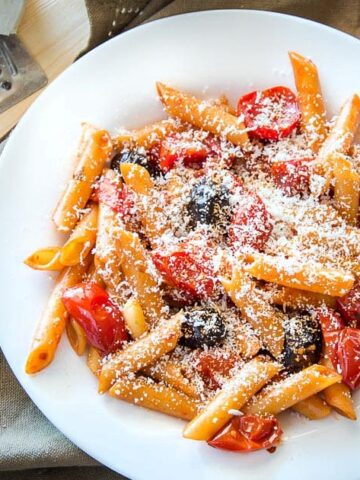
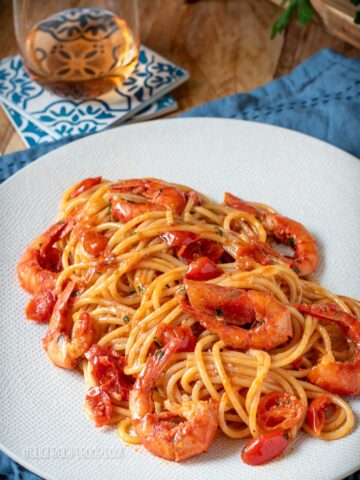

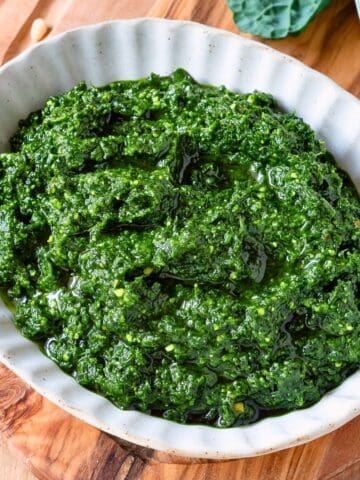
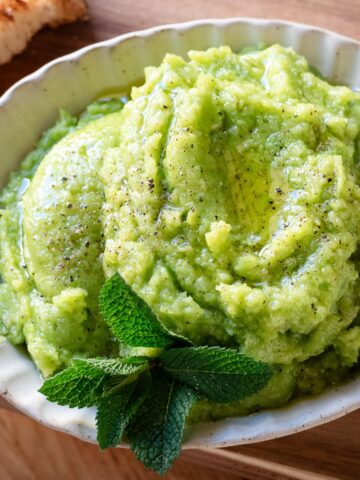
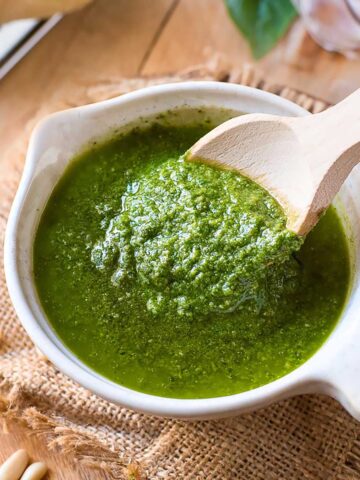
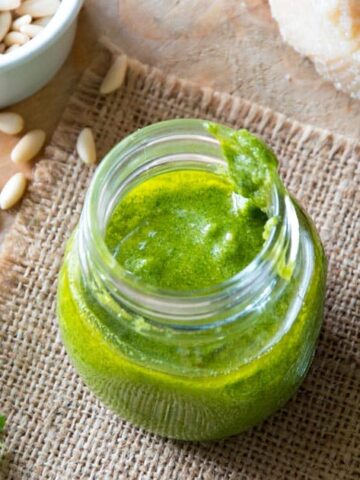
Leave a Reply